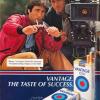
Joseph Tese
Premium Member-
Posts
132 -
Joined
-
Last visited
About Joseph Tese

Profile Information
-
Occupation
Gaffer
-
Location
North Carolina
Contact Methods
-
Website URL
www.joetese.com
Recent Profile Visitors
4,710 profile views
-
I recently re-watched Swiss Family Robinson (1960) and the intro sequence of the ship in a storm impressed me. I simply don't know what capabilities were normal for the time (high budget or not) and how they were able to pull certain things off. Some of it looks so real, and then other parts like the wind/atmosphere/water look generated. Practically, how did they pull off the storm? What type of equipment was at their disposal to do this? And where (physically) do you think they shot (On-Location) vs (Completely Fabricated Environment)? I wish I could find a higher quality video, but here:
-
Long Run of RGB Chase Sequences for News Set
Joseph Tese posted a topic in Lighting for Film & Video
Hello, I'm helping with the design and lighting of a news set that will feature long runs of horizontal and vertical RGB chase sequences. There will be a long line of frosted plexiglass embedded into the wall that will be backlit with the lights. I'm wondering what RGB lighting will provide good results, without also breaking the bank. Knowing it will be diffused heavily by the frosted glass, I'm curious if I need tight pixel control such as titan tubes, or if there are more cost effective options that don't have as "smooth" of a gradient. Obviously, these lights need the ability to daisy chain together with DMX to be seamless over a longer span. I'm not trying to cheap out here, but knowing where these lights will live (behind frosted glass as a background element on a wall, vs Skin Tones) I'm also wondering if some lights more popular in the theatre/live event world will be suitable... or if I will run into color issues on camera. -
Hello, I might invest in some diopter/close-up filters for macro work. For my application, I will be utilizing a mattebox that can accept circular filters with step up/other adapters, or 4x5.6. But I've only seen them in circular format. I'm sure there's a scientific reason for this, and practical cost reason as well. Regardless of the drop-in method.. On Schneider's website, it seems they are only offered in one large size. This leads me to believe that you can use a diopter that is larger than the outer diameter of your lens?- or Would it change the amount of magnification (or anything else for that matter) if there is a diameter difference between the filter and camera lens? I just want to make sure if I invest in a large diopter(s), it won't matter whatever camera lens I use it with. And if it does, what I should be cognizant of.
-
Hello, I building a shoulder rig with a BMPCC 6k PRO. When it comes to rungun situations where I may not have a 1st pulling for me remotely, does anyone have any rig recommendations for pulling focus without having to compromise my hands from being on the shoulder rig handles. My go to thought was to get a focus motor and wirerless controller which would be rigged onto/next to the handle. But this is another piece of electronic gear for these smaller situations, where I would still appreciate the simplicity of manual FF systems. The Zacuto Z-Drive seems to do exactly what I would want, but I heard mixed reviews. I wonder if a whip can securely be positioned next to the handle without being too clunky . Is there another piece of hardware that can accomplish this?
-
led fresnel purchase assistance
Joseph Tese replied to Jason McAdam's topic in Lighting for Film & Video
If you plan to utilize gels often, specifically for intense cct changes or color effects, you have to consider the color accuracy issues with gelling LEDs. It’s not like gelling tungsten. Slight alterations from the led base color are more widely accepted. -
Cheaper alternative to snapgrid?
Joseph Tese replied to Roger Alexander's topic in Lighting for Film & Video
-
Lighting a second story window in a tight space
Joseph Tese replied to imran qureshi's topic in Lighting for Film & Video
It seems like you come up with something you’re relatively happy with. Because the light is so close to the window, the falloff is great, as you know, though. I understand it’s a student film, but it also might be worth mentioning the idea of using mirrors. One could rig mirrors and then blast jolekos or something with a long powerful from the ground, creating a more uniform source. But then you again have the issue of getting the mirrors high enough and at a 45degree orientation. thinking even crazier one could see what sort of options there are to rig from the roof - but this is absolutely not recommended without proper safety gear, professional rigging crew and equipment, etc. Remember..safety. I don’t think this is practical advice for your situation, but fun to think about more possibilities as an exercise. -
There’s a bunch out there, but here’s a small, simple, portable one in light of the op’s needs. https://www.bhphotovideo.com/c/product/833611-REG/CHAUVET_DMX_4LED_DMX_4LED_4_Channel_Dimmer_Pack.html/qa It just depends on what your needs are..mainly power. That pack is not rated for a single 1500watt globe, for example. But there are more beefier dimmer packs out there, that may have an “input” of something other than edisons, like Bates or cams. For the wireless side, you have to choose a wireless protocol, which will determine your wireless hardware and visa versa. CRMX (also known as Lumenradio) is widely popular and many led manufacturers incorporate their chip into the fixtures directly now. There are many wireless dmx devices that use this protocol, like a Ratpac Cintenna/AKS combo. The cintenna goes into the dmx port of the dimmer pack. The AKS is your transmitter, and can connect wirelessly to your iPad (it makes its own WiFi signal) if you wish to configure it that way. Your iPad can run software like Luminaire , or if you’re feeling spicy use the Blackout app, which offers more customization. Also, it may be worth noting that Dadco makes lunchbox/dimmer combos that have wireless transceivers built into them, to help consolidate some of your pieces.
-
Maybe (at least the far flag) is shielding unwanted light on the casino dealer/extra. But blocking shadows from the camera movement makes sense too.
-
Aputure has made led practical bulbs with built in wireless technology. But if you want to dim incandescents, you can get a simple Edison dimmer pack that has dmx. Then put any wireless dmx dongle you’d like in there, and connect it to a board / whatever.






